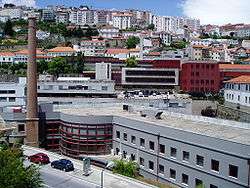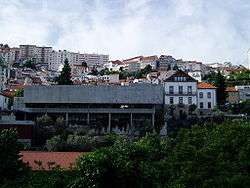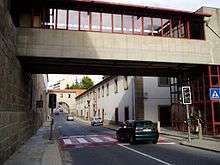University of Beira Interior
| Universidade da Beira Interior | |
 | |
| Motto | Scientia et Labore Altiora Petimus |
|---|---|
| Type | Public University |
| Established | 1979 |
| Rector | António Carreto Fidalgo |
Administrative staff | 693 (professors) |
| Students | 6,879 |
| Location | Covilhã, Portugal |
| Campus | Urban |
| Website |
www |
The University of Beira Interior (Universidade da Beira Interior or UBI for short) is a public university located in the city of Covilhã, Portugal. It was created in 1979, and has about 6,879 students distributed across a multiplicity of graduation courses, awarding all academic degrees in fields ranging from medicine and biomedical sciences to aeronautical engineering to mathematics. The university is named after the historical Beira region, meaning Beira Interior the most interior area of Beira, mainly composed by the district of Guarda and the district of Castelo Branco, in today's Centro region.
History
In August 1973, following a major change in the national higher education system, the government established a polytechnical institution in Covilhã, the Polytechnic Institute of Covilhã (IPC - Instituto Politécnico da Covilhã), which was the first higher education institution in the city. Over the years, the IPC facilities, as well as the enrolment and staff, never ceased to grow. This growth and the region's needs, led the IPC to a remarkable level of achievements that granted it, in 1979, to be promoted, by the Portuguese Ministry of Education, to a higher institutional level, university institute. Seven years later, in 1986, the University Institute of Beira Interior was granted full university status and renamed University of Beira Interior (Universidade da Beira Interior).
Organisation
For teaching and research purposes, UBI is organised into five Faculties. The Faculties are organised in Departments:
- The Faculty of Sciences includes the Department of Mathematics, Informatics; Physics; and Chemistry.
- The Faculty of Engineering Sciences includes the Departments of Textile Science and Technology; Paper Science and Technology; Electromechanical Engineering; Civil Engineering; and Aerospace Sciences.
- The Faculty of Human and Social Sciences is made up of the Department of Management and Economics; Department of Sociology; Department of Education Sciences and the Department of Sports Sciences.
- The Faculty of Arts and Letters includes the Department of Communication and Arts; and the Department of Letters
- The Faculty of Health Sciences includes the Department of Medical Sciences.
All departments of the university grant the undergraduate licenciado degree (licentiate's degree or bachelor's degree), which requires a three-year full-time study programme. UBI also awards postgraduate courses in the fields that are offered by its departments, granting the degrees of mestre (master's degree) and doutor (Ph.D.).
In order to supply its own needs and those of the local community itself, the university has also five centres: the Teaching and Learning Resources Centre (CREA); the Centre for Patrimonial Studies and Recovery (CEPP); the Computer Centre (CI); the Optics Centre (CO) and the Centre of Studies for Regional Development (CEDR) which establishes the interface between the university and the community providing consulting services to local institutions in the areas of regional development.
The Centro Hospitalar Cova da Beira (Cova da Beira Hospital Center), with facilities in Covilhã and Fundão, is the teaching hospital of the University of Beira Interior. Hospitals of Castelo Branco and Guarda also collaborate with the Faculty of Health Sciences.
Rectoral Team
The Rector is elected by the General Council for a term of four years and is assisted by Vice Rectors and Pro-Rectors in specific tasks.
Rector: António Carreto Fidalgo
Vice-Rectors: Mário Lino Barata Raposo (Finance Area and Projects), Paulo Rodrigues Lima Vargas Moniz (Research Area) and João Manuel Messias Canavilhas (Teaching, internationalisation and career prospects)
Pro-Rectors: Isabel Maria Romano da Cunha (Quality Area), José Carlos Páscoa Marques (Project Area) and Manuel Carlos Loureiro Lemos (Coordination with the Community in the Health Area)
Courses


1st Cycle Degrees
- Bioengineering
- Biochemistry
- Biotechnology
- Biomedical Sciences
- Cinema
- Communication Sciences
- Computer Science and Engineering
- Fashion Design
- Industrial Design
- Multimedia Design
- Economics
- Electrical and Computer Engineering
- Electromechanical Engineering
- Portuguese and Spanish Studies
- Management
- Industrial Chemistry
- Marketing
- Optometry - Vision Sciences
- Political Science and International Relations
- Psychology
- Sciences of Culture
- Sociology
- Sports Sciences
- Web Informatics
Integrated Master's Degrees
2nd Cycle Degrees
- Biochemistry
- Bioengineering
- Biomedical Sciences
- Biotechnology
- Branding and Fashion Design (Assossiation)
- Cinema
- Clinical and Health Psychology
- Computer Science and Engineering
- Fashion Design
- Industrial and Technological Design
- Multimedia Design
- Didactic, Cultural, Linguistic and Literary Studies
- Economics
- Electrical and Computer Engineering
- Electromechanical Engineering
- Entrepreneurship and Social Innovation
- Teaching of Physical Education in Basic and Secondary School
- Entrepreneurship and Firm Creation
- Entrepreneurship and Social Service *
- Game Design and Development
- Geographic Information Systems
- Gerontology *
- Industrial Chemistry
- Industrial Engineering and Management
- Information Technologies and Systems *
- Journalism
- Lusophone Studies
- Management
- Management of Health Units
- Marketing
- Mathematics for Teachers
- Mechanical Engineering *
- Medicinal Chemistry
- Optometry in Vision Sciences
- Pedagogical Supervision
- Political Science
- International Relations
- Sociology: Exclusion and Social Policies
- Sports Sciences
- Strategic Communication: Advertising and Public Relations
- Teaching of Mathematics in the 3rd Cycle of Basic Education and in Secondary Education
- Teaching of Philosophy in Secondary Education
- Teaching of Physics and Chemistry in the 3rd Cycle of Basic Education and in Secondary Education
- Teaching of Portuguese and Spanish in the 3rd Cycle of Basic Education and in Secondary School
- Teaching of the Visual Arts in the 3rd Cycle of Basic Education and Secondary Education
- Textile Engineering
* Will not accept students in the academic year 2016/2017
3rd Cycle Degrees
- Advanced Materials and Processing (Association)
- Aeronautical Engineering
- Biochemistry
- Biomedicine
- Chemistry
- Civil Engineering
- Communication Sciences
- Communication Studies: Technology, Culture and Society
- Computer Engineering
- Economics (Association)
- Education
- Electrical and Computer Engineering
- Fashion Design (Association)
- Industrial Engineering and Management
- Management
- Marketing and Strategy (Association)
- Mathematics and Applications
- Mechanical Engineering
- Medicine
- Paper Engineering
- Pharmaceutical Sciences
- Philosophy
- Physics
- Political Science (Association)
- Psychology *
- Sociology
- Sports Sciences
- Textile Engineering
Enrolment and staff
Current figures show an enrolment of approximately 7000 students from all over the country plus 693 professors and lecturers.
Students coming from other European Union member-states and PALOP (Países Africanos de Língua Oficial Portuguesa) countries accounts for nearly 200. + info
Teaching and learning methods
All courses are taught in Portuguese language, and the teaching process is undertaken using a mixture of theoretical and practical processes. Theoretical lessons are usually supported by:
- Theoretical/Practical lessons where the students guided by the teacher have the chance to discuss and resolve problems.
- Practical lessons, where the students are challenged to solve practical problems in laboratories, ateliers or computer facilities and able to apply the theoretical knowledge that they already understood and learned.
Academic year
The Academic year at UBI consists of two semesters. The first (Autumn and Winter semester) is 20 weeks long. It runs from mid September to mid February and includes classes, work assessment and examinations of students. The second (Spring and Summer semester) is 20 weeks long. It runs from mid February to mid July and includes classes, work assessment and examinations of students. Christmas time holidays has two weeks. And Easter time holidays has one week.
University campus



Over the years, the UBI had a remarkable evolution and nowadays it is a modern university full of well-equipped laboratories, ateliers, libraries, computer rooms, research centres, and offering a wide range of activities through the students' union (Associação Académica da Universidade da Beira Interior) and university social services.
The university academic campus is well integrated in the city urban network and it has unique characteristics based on Covilhã industrial roots. The city was an important textile centre, once known as the "Portuguese Manchester". Over the last decades the city witnessed a restructuring of this industry. However, many factories were not able to meet the requirements of the global market and had to close down. Some of their former buildings, after being renovated by the University of Beira Interior, are started the 21st century serving the noble purpose of educating the Portuguese society.
Over 250,000 m2 of buildings are dedicated to academic activities and social services. The university campus is divided into several spaces, called Pólos, which are spread through the city establishing a real symbiosis between the city and the university as a public institution.
The synopsis below provides information about the Pólos of UBI and its libraries:
- Pólo I - The main building is a 17th-century textile factory that was renovated to house part of the university services, classrooms and offices. New buildings near have been erected over the years to keep up the continuous growth of the UBI. Due to a diligent renovation work this set of buildings are considered historical, cultural and architectonical outstanding pieces of industrial archaeology. Among this sector the following units are located: the Faculty of Arts and Humanities, the Faculty of Sciences, the Faculty of Engineering Sciences, the Wool Museum, the Computer Centre, the Optics Centre, the São Martinho Chapel, the Main Library, the Bank, the Teaching and Learning Resources Centre (Multimedia Centre) and the Centre For Heritage Studies and Recovery.
- Pólo II - On a hill, less than 1 km from Pólo I, and meeting the UBI need for constant expansion, an area was created where several central infrastructures, as the emblematic 16th century convent that nowadays houses the Rectory, the administration services and the international relations office. In the same area are also located the academic residences, Santo Antonio cafeteria, the sport halls, the social affairs centre and the centre of studies for regional development. The Department of Sports and Science is also located nearby.
- Pólo III - This is where the Faculty of Health Sciences is located. It has a total area of 16,000 m2 situated nearby the Central Hospital in a distance of 1 km far from Pólo I.
- Pólo IV - This area is located in northern part of the city and was created to facilitate the expansion of the university. It houses the Faculty of Human and Social Sciences, the Cyber Centre and a residence hall with Snack Bar.
- Libraries - UBI has three libraries. The Main Library is located in Pólo I following the aim of meeting the students' needs. All libraries of UBI have an information desk where one can obtain information and help. Once the Library Card is issued, students can use it to borrow books from any library. The Main Library offers a wide range of services spread among 3 different floors. Textbooks and course materials, scientific publications, bibliographies and reference works in all subjects taught at the University are available. Among other services, students can use the individual study and reading rooms, Inter-Library loan service, photocopy services, scanners, CD-ROM, Videos, DVD or consult the Library Database and Internet (200 computers).
UBI residence halls
The UBI maintains 7 residence halls. One of the residence halls is located in Pólo II, 5 minutes of walking distance from the university's main buildings (Pólo I) and the other (Residência Pedro Álvares Cabral) is located near the Pólo IV. All the rooms are equipped with closets, desks, chairs, beds and central heating. One or two students are assigned to each room. The Students' Social Affairs Centre manages all the university housing offers.
Students' union
The students' union, AAUBI - Associação Académica da Universidade da Beira Interior , is headquartered within the old part of the town, near Santa Maria church. The union also has its office in Pólo I, two floors upstairs from the bank.
The students' union (AAUBI) offers a wide range of activities concerning sports, culture and leisure. During the whole year there are many indoor events such like chess meetings or activities in sports halls as climbing, volleyball, basketball, football, badminton and table tennis.
A freshmen reception week, organised by the students's union of the University of Beira Interior, takes place in November and includes a parade through town (the Latada) and several concerts.
Online radio, television and journal
The university has an online radio - Rádio Universitária da Beira Interior , an online television - Televisão Universitária da Beira Interior , and an online journal - Urbi et Orbi .
Athletics
The University of Beira Interior has two indoor sports pavilions, among other sports facilities. Competitive varsity sports teams of UBI include badminton, basketball, futsal, handball, rugby union and volleyball.
Wool museum

The UBI adapted the buildings of the former Real Fábrica de Panos (Royal Textile Factory), an important national woollens manufacturer established by Marquês de Pombal in 1764. This building served as a spinning, dyeing and weaving mill until 1885, when it was handed over to lodge the Regimento de Infantaria 21 (21st Infantry Regiment), and later the Batalhão de Caçadores 2 (2nd Sharpshooters Battalion).
In 1975, during the recovery and adaptation works of the building, archaeological remains of the old textile mill were discovered. The vats of the former dye-house were found. The discovery was classified as a part of the national cultural heritage and it was carefully recovered and restored. According to the museum's educational role, the discovered structures are helping to portray the dyeing processes used in Portugal in the second half of the 18th century.
Guided tours are available (free for UBI students). The museum is open on weekdays except Monday from 9:30h to midday and from 14:30h to 18h.
See also
External links
| Wikimedia Commons has media related to UBI. |
- University of Beira Interior
- UBI (Pólo I) viewed from satellite
- UBI on Facebook
- UBI on Twitter
- UBI on Instagram
- UBI on Buzz
- UBI on YouTube
- ic mimarlik
Coordinates: 40°16′39″N 7°30′32″W / 40.27738°N 7.50887°W